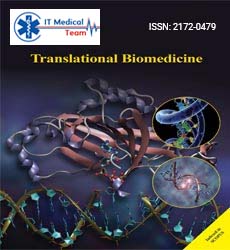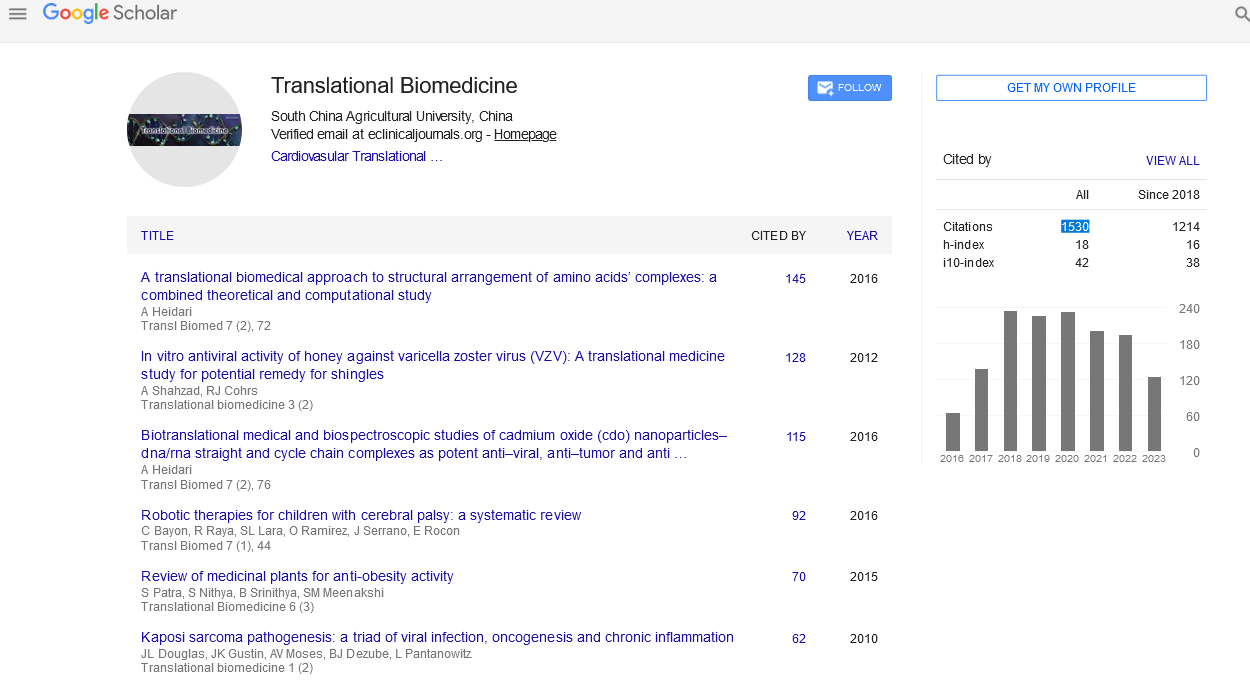Perspective - (2024) Volume 15, Issue 5
Therapeutic Strategies in Translational Biomedicine: Bridging the Gap between Discovery and Patient Care
Neil Shen*
Department of Biomedicine, Medical University, Rome, Italy
*Correspondence:
Neil Shen, Department of Biomedicine, Medical University, Rome,
Italy,
Email:
Received: 10-Sep-2024, Manuscript No. IPTB-24-15183;
Editor assigned: 13-Sep-2024, Pre QC No. IPTB-24-15183 (PQ);
Reviewed: 27-Sep-2024, QC No. IPTB-24-15183;
Revised: 01-Oct-2024, Manuscript No. IPTB-24-15183 (R);
Published:
29-Oct-2024
Introduction
Translational biomedicine is a dynamic field that aims to
expedite the conversion of scientific discoveries into tangible
medical treatments. This process, often referred to as "bench-tobedside,"
involves translating fundamental research into clinical
applications that can enhance patient care. One of the core
aspects of this translation is the development of therapeutic
strategies that address unmet medical needs and improve
clinical outcomes. This article explores the various therapeutic
strategies in translational biomedicine, highlighting their
significance and the challenges associated with their
implementation.
Description
Understanding translational biomedicine
Translational biomedicine encompasses the integration of
basic scientific research with clinical practice. It involves several
stages, including the identification of novel therapeutic targets,
the development of new drugs or therapies and the evaluation
of these treatments in clinical trials. The goal is to bridge the gap
between laboratory findings and their application in real-world
medical settings. Effective therapeutic strategies are crucial for
achieving this goal, as they directly impact the success of
translating research discoveries into practical treatments.
Target identification and validation
The first step in developing therapeutic strategies is
identifying and validating new targets. These targets are often
proteins, genes or pathways implicated in disease processes.
Advances in genomics, proteomics and systems biology have
enabled researchers to identify potential therapeutic targets
with greater precision. For example, the identification of specific
genetic mutations associated with cancer has led to the
development of targeted therapies that address these
mutations.
Target validation is a critical process that involves confirming
that manipulating the target can produce a desired therapeutic
effect. This step typically includes preclinical studies using cell lines and animal models to assess the efficacy and safety of
potential interventions. Successful target validation is essential
for advancing to the next stage of drug development.
Drug discovery and development
Once a therapeutic target is validated, the next step is drug
discovery and development. This phase involves designing and
screening compounds that can interact with the target and
modulate its activity. High-throughput screening technologies
and computational drug design have revolutionized this process,
allowing researchers to rapidly identify promising drug
candidates.
After initial screening, drug candidates undergo a series of
preclinical tests to evaluate their pharmacokinetics,
pharmacodynamics and safety profiles. These studies are crucial
for determining whether a drug is suitable for human trials. The
development of novel drug delivery systems, such as
nanoparticles and liposomes, has also enhanced the ability to
target specific tissues and minimize side effects.
Clinical trials and regulatory approval
Successful preclinical studies lead to clinical trials, where the
safety and efficacy of new therapies are tested in humans.
Clinical trials are conducted in multiple phases, each with
specific objectives:
Phase I: Focuses on assessing the safety and dosage of the
drug in a small group of healthy volunteers or patients.
Phase II: Evaluates the drug's efficacy and further assesses its
safety in a larger group of patients with the targeted condition.
Phase III: Confirms the drug's effectiveness and monitors for
any adverse effects in a large patient population.
Phase IV: Involves post-marketing surveillance to detect any
long-term effects or rare adverse events.
Obtaining regulatory approval from agencies such as the FDA
or EMA is a critical milestone. This process involves rigorous
scrutiny of clinical trial data and adherence to established
guidelines and standards. Regulatory approval ensures that the new therapy meets the necessary safety and efficacy criteria for
widespread use.
Personalized medicine
One of the most significant advancements in therapeutic
strategies is the shift toward personalized medicine.
Personalized medicine involves tailoring treatments based on an
individual's genetic makeup, lifestyle and other factors. This
approach aims to optimize therapeutic outcomes and minimize
adverse effects by considering the unique characteristics of each
patient.
Genomic profiling, for example, can identify genetic variations
that affect drug metabolism and response. This information
allows clinicians to select the most appropriate therapy and
dosage for each patient. Personalized medicine also includes the
development of targeted therapies that address specific
molecular abnormalities in diseases like cancer.
Challenges and future directions
Despite the advancements in therapeutic strategies, several
challenges remain. One of the primary challenges is the high cost and complexity of developing new therapies. The lengthy
and expensive process of drug discovery and clinical testing can
be a barrier to innovation, particularly for rare diseases with
small patient populations.
Conclusion
Therapeutic strategies in translational biomedicine play a
crucial role in transforming scientific discoveries into effective
treatments for patients. By focusing on target identification,
drug development, clinical trials and personalized medicine,
researchers and clinicians work together to address unmet
medical needs and improve patient outcomes. Despite the
challenges, ongoing advancements and innovations continue to
drive progress in this field, offering hope for new and more
effective therapies in the future.
Citation: Shen N (2024) Therapeutic Strategies in Translational Biomedicine: Bridging the Gap between Discovery and Patient Care. Transl Biomed.
Vol.15 No.5: 046





